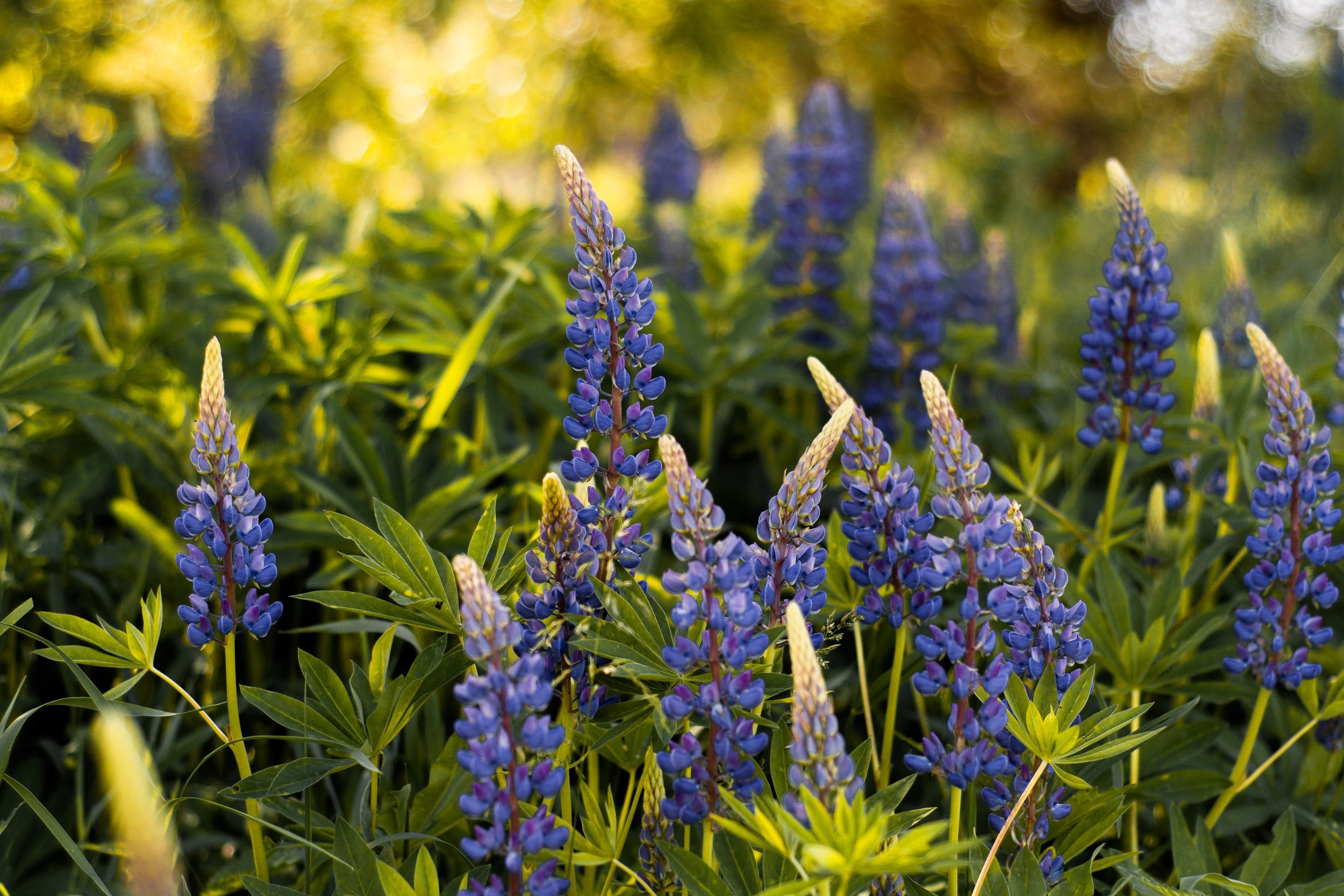How to Grow Lupines
Each year, I try to add new flowering plants to my garden. I almost always choose perennials - not only are they great for pollinators, they are also low effort.
Plant once, perhaps prune or water occasionally, and that’s it! Native plants are even better - and the lupine is one of my favorites.
If you’re thinking about growing lupines in your perennial garden, you’ve come to the right place. This article will tell you everything you need to know about these gorgeous flowering plants.
**J&R Pierce Family Farm is a participant in the Amazon Services LLC Associates Program, an affiliate advertising program designed to allow sites to earn advertising fees by linking to products on Amazon. I often link to Amazon when recommending certain products, and if you choose to purchase, I may earn a small percentage of the sale. It costs you nothing extra, and all recommended products are ones that I personally vouch for. **
Are Lupines Easy to Grow?
If you are looking for an easy-to-grow flower, look no further than lupines. These beautiful blooms:
Come in a variety of colors
Add a splash of color to any garden
Are also relatively drought-tolerant, making them a great choice for gardeners who live in dry climates
Don’t need much watering, fertilizing, or weeding once established
Want to learn more about growing lupines? Check out the video below - and keep reading this post for the ultimate guide on how to grow them.
What Are Lupines?
A lupine plant can grow anywhere from one to a whopping five feet tall and it grows quickly in full sun. This allows you to develop a large cluster for your garden quickly. Growing lupines is pretty easy, as the flower has multiple varieties that have sprung up all over the world and are naturalized to various climates.
While most lupines don’t last for longer than a few seasons, they do self-sow and can spring back next year with a vengeance in your garden. They are great plants that will bring color to any backyard, and anyone can plant them!
The wild lupine is one of the only food sources for the Karner Blue butterfly, which only adds to its importance. If you manage to plant wild lupine in your yard, expect to see several butterflies once the larvae break free from their cocoons!
Lupines often grow around the water, and are great attractors of bumblebees. The blue and purple flowers sit on stems that are about five feet tall, and they are one of the strands that often create most hybrid varieties of garden lupines.
Whether you end up buying a hybrid lupine or lupines that are native to an area, you’ll have a wonderful and colorful plant that will bloom every single spring.
Lupines are often fed to livestock, but this is not something I would recommend - they often poison sheep and cattle when fed in excess and at the wrong time of the year (like when animals are gestating and when lupines are in the toxic seeding stage).
How Do You Seed Lupines?
There are two types of lupines that you can purchase, annual and perennial, and you’ll need to figure out which one works the best for you based on your preferences and your climate. Annual lupines often live about three to five years and then stop blooming.
You can either buy new lupines and replant them or take seeds from your dead plants and plant those. You’ll be able to find the dead seed pods all over the garden, with perfect seeds inside that can be used.
You can also start with seeds that you purchase from a greenhouse - I like these seeds, myself.
Perennial lupines are often regrown by ‘self-sowing’ and leaving seeds all over the garden, and then the seeds will winter and then grow on their own. You can either keep the lupines where they are at the end of each year or you can uproot them and move them to where you want them.
While older lupines can die if they are relocated, younger lupines won’t notice if you move them. In fact, moving your lupines is a good way to encourage future blooms, as it can stop the overcrowding that often kills older, less vigorous lupines.
How to Care for Lupines
Select a wide variety of lupines for your garden, depending on where you live and what color you want. Do you want a lupine that will provide food to butterflies and attract other pollinators? Or maybe you want one that will look colorful and give your garden a new look every spring?
Once you figure out what type of lupine you want, you’ll be able to care for the plant with ease. It doesn’t require too much maintenance and just needs some sun in order to thrive - again, another reason why it’s perfect for the lazy gardener, like me.
Planting
If you buy lupine seeds, you’ll want to plant them in late fall to make sure they bloom by the spring. Set a note in your garden planner so you don’t forget! And use this garden planner if you don’t have one yet.
You’ll need to soak the seeds in warm water to soften their tough shells; otherwise, the seeds will not absorb water and won’t grow. Do this for a few days before planting. Make sure you get the seeds into the ground at least a few weeks before the first expected hard frost so that they have time to set roots.
Choose a location that receives plenty of full sunlight and is amended with plenty of fertile compost. You don’t need to fertilize the lupines during the regular growing season, but a bit of added nutrients at the beginning of their lives can be just what they need in order to thrive.
Keep them watered and the seedlings will sprout after two weeks to a month. If you don’t want to bother with seeds, you can always plant potted lupine plants in the spring, and they will start to grow immediately. Whichever option you choose, the seeds or root need to be buried deeply - check your plant tag or seed packet to make sure you are planting at the proper depth.
Watering
Like almost all other plants, lupines will need regular watering at the beginning of their growth. Since the plants have very long and deep roots, make sure that you are giving them water every few days to strengthen their roots.
Once the plants start to grow, the long roots enable them to lock in moisture, and they can go with much less water.
If conditions in your garden are dry and drought-like, then you will need to water them occasionally. Otherwise, they can survive on one inch of water a week and won’t need regular watering. You can always install drip irrigation systems like these but I’ve never found them to be necessary.
Soil Type
Lupines are very durable in terms of what soil they can handle. They can grow in soil with a very high or very low pH level but do prefer to grow in neutral soil. They don’t need loam or any additional fertilizer, and even poor soil can encourage the lupines to grow longer roots.
Just make sure that the soil you plant the lupines in is somewhat well-aerated and not too heavy. This will encourage good drainage, as that is a staple for healthy lupines.
Light
Lupines might not demand much with water and soil, but they do demand full sun in order to produce the most prolific blooms. When you live in a colder climate, then you can expose your lupines to full sun. If it gets warmer where you live, then filtered or partial sunlight is best to avoid scorching the leaves - although you will be sacrificing some flowers and bloom.
When lupines are shielded from the sun completely, they will not produce any flowers. You’ll need to keep that in mind if you have areas in your garden that don’t get any sun.
Fertilizer
Unlike most flowers, lupines are accustomed to growing in harsh environments and do not need any fertilizer to grow. In fact, if you add too much fertilizer, it can produce the opposite effect and cause the lupines to fail to bloom. That’s because lupines are able to utilize nitrogen from the air and don’t need extra fertilize - too much fertilizer will simply cause foliage production at the expense of the bloom.
Common Pests and Diseases of Lupines
One of the reasons that lupines don’t like hot weather is because it spawns powdery mildew, which can damage the leaves. You should be able to see white powdery splotches on the leaves, which can kill your lupines. In order to prevent this, you should use fungicides and plant your lupines in cold weather to make sure the mildew doesn’t get in the leaves.
Aphids and other pillbugs (such as the roly-poly) are also some major enemies of lupines. They eat the leaves and flowers and can be real pests. If you don’t want to use pesticides to keep them away from your lupines, then you can use a few tried and true natural repellants.
For example, you can spray the aphids off with a hose or remove them by hand with gloves, or use soap, essential oils, and water to form a natural spray.
For another natural way to get rid of aphids, you can introduce natural predators to the garden to prey on them. These predators are beneficial to your garden, and aside from hunting the aphids, they won’t cause any problems to your garden.
You can bring in ladybugs, birds, and green lacewings to help cull the aphid population. If you have small trees or places where they can build nests, they will live nearby and snack on the aphids every chance they can!
Thankfully, pillbugs are the only pests that eat lupine leaves and seeds. Once you repel them and take care of other pests and diseases, like powdery mildew, then your lupines will be safe and ready to bloom as soon as the weather allows.
Make sure you cut a gorgeous bouquet to use in your home!
There you have it! Everything you need to know about growing lupines. Do you grow them - and if not, what are your favorite flowers to cultivate in your garden? Let me know in the comments!
Want to learn more about farming? Be sure to check out these featured articles!
Subscribe to our email newsletter for regular tips and tricks on homesteading – wherever you are. You can also follow us on Instagram (@jrpiercefamilyfarm) and Pinterest (J&R Pierce Family Farm) for frequent updates. Happy homesteading!






